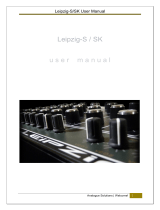
2.2 SAVE AND LOAD SEQUENCES
Set the switch to the LOAD position. The REST/YES button will begin to ash. You can select 16
presets to load, which are divided into 4 banks of 4 sequences. Select a BANK by holding down the
PLAY button and at the same time use the rotary switch. The 4 positions of the rotary respond to the 4
banks. Then with the PLAY button, you can select 1-4 sequences with the rotary switch. You can use
LOAD while the sequencer is playing.
If you want to cancel, just do not press YES and set the switch to the middle position.
In order to SAVE a sequence, just follow the same procedure as above, but instead, set the switch to
the SAVE position.
2.3 PLAY MODE
This is where you can reproduce recorded sequences, or where you
can actually use Dysmetria as a synth with a midi keyboard.
PLAY/PAUSE = Start, Pause and continue playing a sequence.
Hold down PLAY/PAUSE = SHIFT
STOP = Stop the sequence
PITCH slider = Adjust the playing pitch. By default this should be at
50%, so as to play the recorded notes. This way you can transpose
the pitch up and down.
VELO slider = Adjust the total velocity. By default this should be set
at 0%.
ACCENT slider = Adjust the total accent. By default this should be
set at 0%. Accent applies to Amp level and to Filter EG level
TEMPO = Set the tempo from 20BPM up to 240BPM.
SHIFT + TEMPO = Divisions : 4/8/16/32 - This is stored per sequence
PITCH patch = 1v/oct output of the sequencer
VELO patch= Velocity output. As velocity is not hardwired, it must be
patched in order to work
MIDI patch = MIDI input jack. Requires a Type A DIN5 to 3,5mm
cable adapter (included)
CLOCK patch = This can be setup as a GATE IN/OUT or CLOCK
IN/OUT from the global settings. For more info, check the CLEAR
MODE paragraph.
2.4 REC MODE
This is where you record sequences. There are two ways to do this. Either with your midi keyboard, or
by inputing values with the onboard controls.
To start editing, set the rotary switch to REC. To start editing, press the NEXT button once.
Now, the edit will forward you to the step that your sequencer was left at. If you had it on pause on the
5th step, this will allow you to edit the 5th step. If you want to make sure that you will edit the rst step,
go to PLAY mode and press STOP before proceeding with REC.
- So, once you press NEXT, you will enter the rst step (or whatever step you were at) in order to start
recording. Here you can change the Pitch, Velocity, Accent, Ratcheting or set the step to a rest. Each
time you make a change, the step will be triggered.
- Once you are done with your current step, press NEXT and this will allow you to edit the next step.
Again set this and press NEXT.
- When you are done and you want to end a sequence before the 32 steps, just press NEXT+REST
at the same time.









